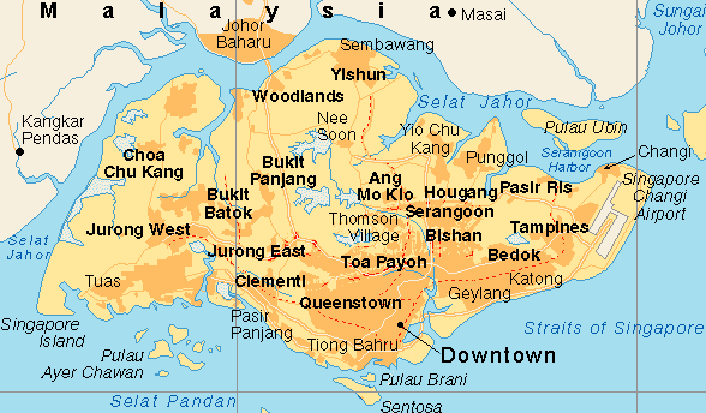
HOME | SURVEY | PHOTOS | ACKNOWLEDGEMENTS
SINGAPORE MAP

MRT LINES IN SINGAPORE
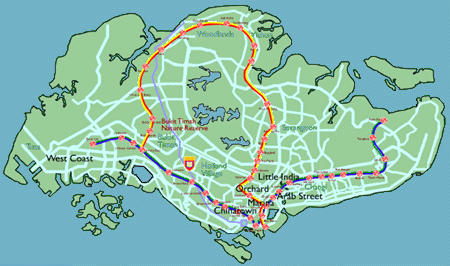
WRITTEN REPORT
INTRODUCTION:
Over the recent years, with the globalization and growing sophistication of Singapore, places for recreation and relaxation is playing an increasingly important role, in relieving stress for the modern day Singaporean. Although there has been a recent proliferation of shopping centers, bowling allies and so on, there is notable number of people who still appreciate the aesthetic value of nature. This is derived from our findings that comprise results of 64 survey forms. The interviews were conducted on 12th December 1999, 31st December 1999 and 8th of January 2000. (Weekend and weekday and public holiday) On average, our group spent a duration of about 3 hours on each visit interviewing people, taking measurements for the beach transect and photographs. In our project, we present East Coast Park's sphere of influence, the reasons for its attractiveness, factors affecting its popularity, possible improvements and as well as related concerns.
SPHERE OF INFLUENCE OF EAST COAST:
The sphere of influence defines as the area over which an urban center distributes its services. In this instance, the "urban center" would refer to East Coast Park as its central spot.
For East Coast, its influence stretches from far off Bukit Panjang to Whampoa, right down to Tampines in the east and as well as just next to it. Contrary to a common perception that parks have a small sphere of influence, East Coast's is quite extensive. However, East Coast Park itself is uniquely different from the others. Situated next to the sea, it covers a huge piece of land and provides a host of activities; it is almost one of a kind. (Pasir Ris Park is similar too, however, it lacks the sea) The main reason for its wide sphere of influence is dependent on several following factors.
TRANSPORTATION MODE OF GETTING TO EAST COAST
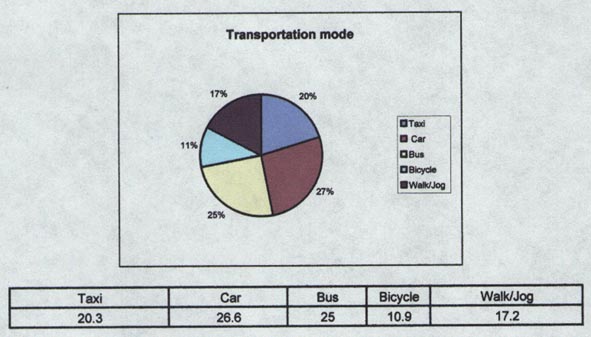
As from the results, the taxi is the best alternative of getting to East Coast. This could be attributed to the fact that most Singaporeans do not own cars and that there is poor accessibility of bus services. Most of the people who walked, jogged or cycled to East Coast stayed within close vicinity. As conferred from the general comments made by the surveyees, they would come more frequently if there were a more efficient transport network to East Coast Park. Therefore, accessibility is a factor, which directly contributes to its sphere of influence.
DO SPENDING COSTS DETER PEOPLE FROM VISITING ?
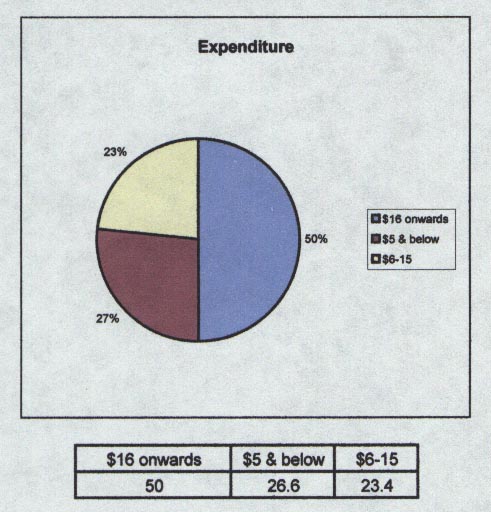
Our team thought that the factor of money would have a direct effect on East Coast's appeal. However, as seen from the results, spending costs is not an issue here. Instead, it may have to do with the number of people who are accompanying. It is noted that the big spenders came in large groups---either as a family or for beach barbeque and chalets. Their expenditure ranges from $50 to a few hundred. Therefore, the larger the group, the more money likely to spend. (This is not taking into consideration those of the fishing activity and those that go there to enjoy nature purely, and for picnics. These people spend the minimal amount.) East Coast attractiveness and long lasting appeal rests on amenities such cycling and in-line skating. Such activities will also add to the monetary cost of an outing at East Coast.
REASONS FOR GOING TO EAST COAST:
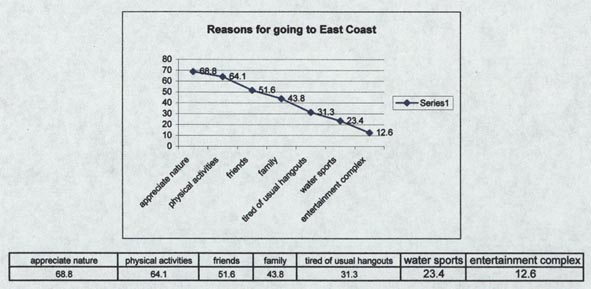
Most people visited East Coast because of its nature, despite the fact that it was a man-made beach. Hence we can assume the greatest attraction of visiting East Coast is its relaxing environment and scenery, followed by the sports (land) activities as the surveyees' greatest motivation. The purpose of the visit is a vital factor towards East Coast's sphere of influence. Without any motivation, East Coast would only have a small sphere of influence.
FREQUENCY OF VISITATION
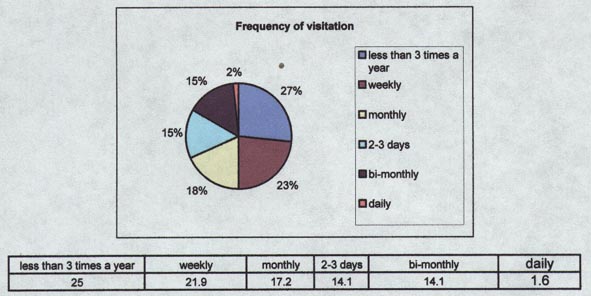
East Coast is popular among Singaporeans during weekends and school holidays, hence during the longer school breaks would we see larger number of people. Since most people live far from East Coast and that accessibility is a problem, a small percentage of 1.6 could be attributed towards inconvenience of transport and as well as the fact that many of the surveyees prefer to go to the beach in groups, thus limiting their number of visits. However, the frequency also depends on the availability of time on their personal schedule.
SHOULD THERE BE IMPROVEMENTS MADE TO EAST COAST?
Generally, the responses "YES". A minority feel neutral towards an improvement in East Coast Park because they are satisfied with its present condition, and that there is no necessity to improve. There was some who commented that there have been visible efforts from the government, such as improved toilet facilities. There was one 50 year old lady who felt strongly that the government should not improve the coast, but rather to leave it in its natural state. This feeling is mutual amidst most of the surveyees. They would like its natural state to be preserved as much as possible, and that it shouldn't be developed towards building a bustling area with a shopping mall and pubs. however, there is a minority particularly in the younger people, who think otherwise.
Definitely, more people will be attracted to go to East Coast Park more frequently if there are improvements made.
SUGGESTIONS
FOR IMPROVEMENT
With regards to leisure activities, there could be more variety of water sports, such as jet-skiing. Also, more children’s playground, more family-participating activities and pubs and shopping centers. For infrastructure, many suggested more bus services ( one suggested every day of the week) and a direct MRT line. Amenities-wise, there could be more shelters, more toilets, individual enclosed bathing cubicles and more food varieties. (special comment made by an expatriate’s wife) About cleanliness, to have cleaner toilets and as well as the litter along beaches to be cleared. There were two elderly women who were very concerned about safety of the children, especially with the badly eroded parts of the beach.
Some
offered some solutions to some of the problems. They think that public education
is vital and that implementing fines is not the solution.
GOVERNMENT'S
EFFORT IN PRESERVING EAST COAST
Since
the month of January (and still on-going), the cycling tracks are undergoing
renovation for widening and also, the old pipes have been changed. Perhaps this
is to allow a more efficient drainage of seawater when tide level rises to an
abnormally high level. This is especially important during the monsoon seasons
in December. As seen from the photograph, the piles of sand that was washed
inshore to the walkway and cycling path, all the way from the shoreline has been
removed and it is laid barren.
Red
and white coloured barricades are to keep people away from the potentially
unstable grounds of coastal erosion. To reduce the erosional effect, the
breakwaters were constructed to dissipate the high-energy waves from attacking
the coastline. However, as East Coast is not a natural beach, erosion will still
occur.
In
early January, workers were seen shoveling, removing the washed up sand on the
pathways and dumping it back to the beach. (Our teacher adviser pointed out to
us the softness of the sand, and how easily our feet sunk into it, as we walked
along the coastline. This is so because the sand has been piled on recentl
RELATED
CONCERNS: EROSION AND POLLUTION
During
a low tide, our group did a beach transect measurement of 3 eroded sites of the
beach, starting from the walkway and ending at the waterline. The results
reflect the extent to which erosion had acted on it. We measured sharp changes
of the degree of angles along the slopes. On our first site, we had an abrupt
and sharp drop of about 18.5cm. For our 2nd site, there was a variation of 3-4
degrees change of angle. Our 3rd
site bared similar results
too. Hence, erosion does occur along East Coast’s beach.
Some
feel that the situation is difficult to rectify. They hope that the government
will do something about it. Most of them are not aware of the magnitude of the
erosion problem, therefore they have to be prompted by us to give a response.
Basically, there were some who did not know or think about it at all, hence
their response was lukewarm.
With
regards to those who had a basic knowledge of erosion, they were more concerned
as to what the government plans to do. One suggested refilling the beach with
more sand. However in general, there were no concrete ideas offered for a
permanent solution.
Singapore’s
port is important to our economy. As a bustling port with a regular flow ships
moving in and out of our surrounding waters, small amounts of oil to wash up on
our shores. We cannot prevent this, unless there are stricter regulations
imposed on the ships occupying the surrounding waters. However, this is not a
feasible option, considering that trade activity may be adversely affected,
hence also affecting our trade activities and economy.
DIFFICULTIES
ENCOUNTERED
It
was our first time carrying out a survey and initially, we felt nervous about
approaching people for an interview. Communication-wise, we could not converse
with some of the foreigners we approached, and as well as relate some
geographical terms in our mother tongue. We all felt that question 6 of our
survey wasn’t phrased well, and our surveyees experienced difficulties in
understanding it. There were some occasions when we planned to go down to East
Coast, but it rained and we had to make another arrangement. One of our group
members received weird looks and laughter from a group of teenagers when he was
attempting to take photographs. As for the tallying of results, we made a few
mistakes in the initial addition. So, we had to count several times through the
survey forms to make sure the figures were correct, and then make the grand
total.
DONE
BY:
Madeline
Lin ( 2A5)
Benjamin
Ng (2A4)
Melissa
Chiew (2A4)